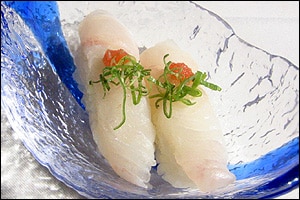Hirame and Ohyo Sushi (Fluke And Flounder Profiles)
What are Hirame and Ohyo (Fluke And Flounder)?

Winter flounder is actually called karei in Japan. If a person were to order hirame in western countries, they would generally be served either fluke, or in some cases it turns out, Halibut.
The Unusual Complexity of The Different Species
Halibut live in both the Pacific and Atlantic oceans, and there are minor differences in those populations. The differences are large enough that they don’t share the same name in Japanese, however. In Romaji (a Latin alphabet used to write the Japanese alphabet for westerners), Pacific halibut are called oyhou (oh-yoh) (or O Hi yo U in Kana, which is the term for syllabic Japanese scripts) and is shortened to ohyo in the west. Sometimes it is actually labeled “oyho,” however this is not the Japanese word for halibut, and the etymology of this mislabeling is not clear.
Atlantic halibut, however, are called karasu garei, which interestingly is translated as “cow flounder.” Halibut remain on the menu of many sushi restaurants as hirame, though, even though this is not the proper term. The difference between all these fish…? When you look at a flatfish of any kind there is a direction it must face in order for the mouth and pectoral fin to look like a “normal” fish.
If you look at a winter flounder it will look to the right. If you look at a summer flounder (fluke) it will look to the left. The rule in Japan is “Hidari Hirame, Migi Karei” meaning “Left Hirame, Right Karei.” The ohyo (Pacific halibut) as well as the Atlantic halibut both face right, and are therefore technically considered “Karei.”
The Time Of The YearAffects Taste and Texture
As with most nigiri-zushi, one order is generally a pair, and in the case of hirame, the meat is taken from the area around the fish’s fin and is called the engawa, which means ‘porch.’ The size of the neta (or tane) can be a clear indicator of the type of fish that is being served as hirmae (Fluke) pieces are often so small that a few (usually two) are needed to top the rice (shari). Ohyo (halibut) will be a single piece of fish on top of the shari.
Hirame is also more common in winter months, when the fish is at its leanest, and in Japan, this is considered the best time to serve hirame. Summer hirame has a tendency to be fattier and mushy, the opposite of the light, clean flavor and firm texture of winter hirame. Halibut, on the other hand, is served year round with consistency.
Fluke (hirame) is a much smaller fish than the halibut (ohyo). It will also generally have a firmer texture than ohyo and will be presented differently due to its smaller size, often as paired, small fillets on top of each piece of rice (shari). Halibut (ohyo) is a much larger fish and is sliced and presented the way any other fish would be, unlike its flat cousin, the fluke.
Seasonal factors come into play as well since fluke is best in the winter months, being less mushy. Of course, simply asking which particular fish is being served is the easiest way of determining what you are eating, however prior to ordering a person might not know what to expect without asking.
Both Ohyo and Hirame are Excellent Choices Fortunately
While both hirame and ohyo are excellent choices, lighter fare with a sweet, subtle flavor, they are most certainly different meats. It is doubtful anyone would be unhappy being served either, they are similar enough, however it is always good to know what you are getting, as an educated consumer will know what to specifically ask for upon subsequent visits to any sushi-ya.
I have always been fascinated by the creation and culture of different foods, particularly sushi and sashimi in the modern era of Japanese cuisine. I am a classically trained chef and sushi connoisseur, also having operated a food service company and enjoy investigating and experimenting with food around the world.